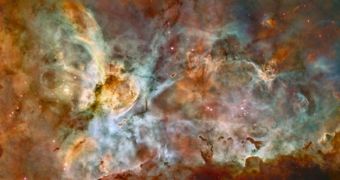The Hubble Space Telescope (HST) is a telescope in orbit around the Earth, named after astronomer Edwin Hubble. Its position outside the Earth's atmosphere provides significant advantages over ground based telescopes - images are not blurred by the atmosphere, there is no background light scattered from the atmosphere and the Hubble can observe in ultra-violet light that is absorbed by the ozone layer.
Since its launch in 1990, it has become one of the most important instruments in the history of astronomy. It has been responsible for many ground-breaking observations and has helped astronomers achieve a better understanding of many fundamental problems in astrophysics. Hubble's Ultra Deep Field is the deepest (most sensitive) astronomical optical image ever taken.
On its 17th anniversary, Hubble gives the world a big present - a 29,566 x 14,321 pixel image (500 MB TIFF image) of the Carina Nebula.
This panoramic image of the nebula gives us a peek into star formation as it commonly occurs along the dense spiral arms of a galaxy.
The Carina Nebula is located a mere 7,500 light years away in the southern constellation Carina, the keel of the old southern constellation Argo Navis. The Carina Nebula is a stunning view of a birthplace of new stars; there are more than a dozen stars present in the nebula that are estimated to have a mass of greater than 50 to 100 times the mass of the Sun. The unreal landscape began its formation around 3 million years ago when the first stars in the nebula ignited amid a cloud of molecular hydrogen.
The radiation that these stars gave off etched away the matter that started out in the nebula. The remaining globs of matter are those that have resisted being destroyed by the intense photoionization. New stars are being formed thanks to the violent stellar wind and intense radiation compressing the surrounding wall of cold molecular hydrogen.
It is believed that our own solar system began in a similar cosmic blast furnace. This image shows that Hubble can still offer an unparalleled view into the outer workings of the universe around us. As our astute NI readers know, the colors are added later, for the interested, the image was taken in the light of ionized hydrogen. Color was later added by the Cerro Tololo Inter-American Observatory in Chile; red corresponds to sulfur, green to hydrogen, and blue to oxygen emission.
Hopefully this image shows just how much can still be learned from an "old" piece of equipment, which is sadly destined to end up as space junk in the not so distant future.

 14 DAY TRIAL //
14 DAY TRIAL //